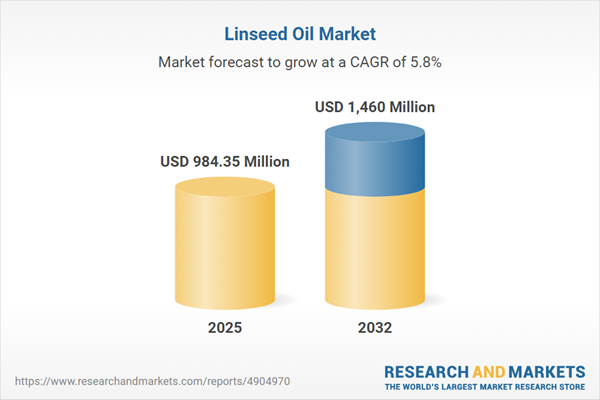Speak directly to the analyst to clarify any post sales queries you may have.
The linseed oil market is rapidly evolving as regulatory standards shift, client expectations diversify, and global supply chains grow more complex. Senior decision-makers require targeted, actionable intelligence to confidently manage risk and guide strategy in this multifaceted landscape.
Market Snapshot: Linseed Oil Market Performance
The global linseed oil market is valued at USD 931.21 million in 2024 and is forecast to reach USD 984.35 million by 2025. The market is projected to grow at a compound annual growth rate (CAGR) of 5.80% through 2032, culminating in a market value of USD 1.46 billion by the end of the forecast period.
Growth momentum is driven by expanding applications in manufacturing, nutrition, and personal care—each responding to more sophisticated regulations and evolving enterprise procurement strategies. Industry participants are revising sourcing approaches, broadening distribution channels, and prioritizing regulatory compliance, leading to greater operational agility and a growing presence across both established and developing markets.Scope & Segmentation in the Linseed Oil Market
Granular segmentation unlocks actionable insights for investment and supply chain optimization within the multifaceted linseed oil value chain. The broad application range, varied extraction technologies, and regional dynamics present distinctive growth avenues and innovation potential.
- Application Areas: Key sectors driving demand include animal feed, chemical manufacturing, food and nutraceuticals, paints and coatings, cosmetics and personal care, pharmaceuticals, specialty inks, and wood treatment. Each market presents specific growth drivers influenced by distinct regulatory and buyer expectations.
- Product Types: Both raw and refined linseed oils serve differentiated industrial applications, providing portfolio flexibility and supporting tailored offerings for diverse client needs.
- Extraction Methods: Techniques such as cold pressed, heat refined, and solvent extraction support efficiency, compliance, and continuous improvement in product quality. Technological enhancements here can address new regulatory requirements and sustainability targets.
- Purity Grades: Availability of both food-grade and technical-grade linseed oils enables manufacturers to align product development with sector-specific safety and performance benchmarks.
- Sales Channels: Purchasing options include direct procurement, distributor networks, retail outlets, and digital platforms. Flexible sourcing models help organizations adapt quickly to market and regional variations.
- Packaging Formats: Standard bottles, drums, bulk shipments, and flexible pouches meet a wide range of customer logistics and delivery requirements, accommodating both large-scale industrial and niche applications.
- Geographies: The market extends globally, with focal points in North America, Latin America, Europe, Middle East, Africa, and Asia-Pacific. The United States, Brazil, Germany, China, and India serve as major distribution and regulatory hubs, influencing market flows and import/export dynamics.
- Leading Companies: Industry participants comprise Cargill, Archer-Daniels-Midland, Natural Factors, Croda International, Prinova Group, United Oilseeds, Barentz International, Barque International, Bioriginal Food & Science, and Omega Processing, among others. Each drives sector standards in quality and operational innovation.
Key Takeaways for Senior Decision-Makers
- Diversifying portfolios across multiple sectors—nutrition, cosmetics, and manufacturing—increases resilience and opens opportunities for collaboration and new market access.
- Implementing advanced extraction technologies and robust quality assurance cultivates trust among enterprise buyers, strengthening reputational standing and customer loyalty.
- Pursuing responsible sourcing strategies and enhancing supplier transparency build more secure, reliable supply chains and align with corporate sustainability objectives.
- Staying attuned to trends in clean-label and plant-based preferences ensures ongoing relevance, supporting procurement needs of B2B clients seeking ingredient transparency and traceability.
- Evaluating and refining digital procurement workflows provides flexibility to respond to shifting raw material availability and tailored client requirements.
- Adopting regionally tailored compliance and purchasing models reinforces risk management, leveraging mature infrastructures in core markets for sustainable expansion.
Tariff Impact: Navigating the 2025 United States Tariffs
The introduction of new tariffs in the United States necessitates strategic updates in sourcing and pricing for linseed oil suppliers. Responding to this shift, enterprises are reinforcing local manufacturing capabilities and strengthening B2B partnerships. These adjustments are crucial for maintaining operational continuity and supply chain resilience.
Methodology & Data Sources
This report draws upon in-depth interviews with sector leaders, thorough review of technical and regulatory materials, and triangulated data from multiple independent sources. This rigorous approach ensures that findings are both reliable and directly relevant for senior executives making critical decisions in the linseed oil market.
Why This Report Matters: Linseed Oil Market
- Supports proactive compliance and supply chain risk management amid a changing regulatory environment and global operational complexities.
- Encourages digital transformation and targeted product innovation to retain competitive advantage across key B2B segments.
- Delivers essential intelligence on certification requirements, supplier partnerships, and sustainability goals, fostering agile and well-informed enterprise strategies.
Conclusion
Current linseed oil market insights enable leaders to anticipate sector changes, reinforce supply networks, and align business practices with sustainable and compliant growth objectives as industry demands and expectations continue to evolve.
Additional Product Information:
- Purchase of this report includes 1 year online access with quarterly updates.
- This report can be updated on request. Please contact our Customer Experience team using the Ask a Question widget on our website.
Table of Contents
3. Executive Summary
4. Market Overview
7. Cumulative Impact of Artificial Intelligence 2025
Companies Mentioned
The companies profiled in this Linseed Oil market report include:- Cargill, Incorporated
- Archer-Daniels-Midland Company
- Natural Factors, Inc.
- Croda International PLC
- Prinova Group LLC
- United Oilseeds Limited
- Barentz International B.V.
- Barque International Limited
- Bioriginal Food & Science Corp.
- Omega Processing, LLC
Table Information
| Report Attribute | Details |
|---|---|
| No. of Pages | 184 |
| Published | November 2025 |
| Forecast Period | 2025 - 2032 |
| Estimated Market Value ( USD | $ 984.35 Million |
| Forecasted Market Value ( USD | $ 1460 Million |
| Compound Annual Growth Rate | 5.8% |
| Regions Covered | Global |
| No. of Companies Mentioned | 11 |









